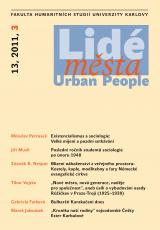Mizení náboženství z veřejného prostoru
Kostely, kaple, modlitebny a fary Německé evangelické církve
DOI:
https://doi.org/10.14712/12128112.3545Klíčová slova:
religion, Czech Lands - 20th Century, Protestantism, German Protestant Church, churchesAbstrakt
This study analyses the liquidation process of the German Protestant Church in Bohemia, Moravia and in Silesia, the fourth largest Czech church, in the era after World War II. The analysis examines the fates of the religious buildings of the church. Research was based on newly discovered archive materials of the Protestant provenience, which also give us a picture of post-war religiousness in the newly re-settled borderlands, as well as on the material gathered in the publication Encyclopaedia of Modern Protestant and Old Catholic Churches in Bohemia, Moravia and Czech Silesia (2009). The existence of the German Protestant Church lost its justification in connection with the post-war movement/expulsion of Czech Germans, the author shows that the liquidation of and the other manipulation with its properties was carried out with a distinctly nationalistic, political and other unrelated motives. The association of the Czechoslovak (Hussite) Church with the Communist regime led to the fact that it temporarily utilised most of the property during the first decades of the regime. In the long-term, however, the higher stability of Protestant communities prevailed, and the dominant "inheritor" of the German Protestant Church's property was the Protestant Church of the Czech Brethren. Some other religious groups also profited from this inheritance. Just over half of the possessions were lost altogether for religious use. However, the secularisation of church property is only one of the causes of religion disappearing from the public sphere; other causes include the weakening of religious life and the de facto self-enclosure of religious communities, whose religiosity was unable to appeal to the wider masses. The remaining religious buildings that still serve their original purpose today are perceived only as "hollows", which by their very existence do not allow understandable, i.e. secular use of space.
Stahování
Publikováno
Jak citovat
Číslo
Sekce
Licence

Tato práce je licencována pod Mezinárodní licencí Creative Commons Attribution-NonCommercial-NoDerivatives 4.0.


